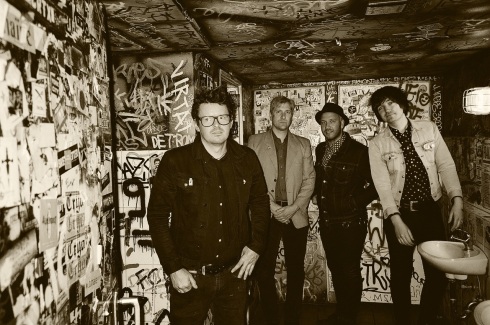
Suspect Parts in the basement of The Franken, Kreuzberg. Photo by Imke Wagener.
Disclaimer: Berlin’s vibrant and frequently turbulent history includes two world wars, war atrocities, surveillance, torture, rape, murder, and of course an incredibly positive transformation into one of the world’s most culturally vibrant cities. I will discuss all of these subjects as they struck a nerve as I dug into Berlin’s stimulating history.
My Brief Background:
In 2008 I was living in Madrid teaching English, singing in the band Mano De Mono, and working as a DJ on weekends. My American rock n roll band Clorox Girls had broken up, and my heart was aching to write and play some new music. My friend Chris Bell from Seattle punk band The Briefs had been living in Berlin in-between touring, and he suggested that we start a side-project. I recorded some of my new songs on a cassette tape and mailed it to Berlin. A few months later we recorded the Suspect Parts debut single in the cold of a bitter Berlin winter. Behind the dials in the engineer booth of a small analog studio was Smail from legendary Berlin punk band The Shocks. After the single was released, we recruited James “Sulli” Sullivan from UK teen heart throbs Ripchord on lead guitar and Smail on bass. After a couple of tours and a couple more singles, Smail was replaced by the affable and ever-capable Andru Bourbon from Berlin kamikazis Radio Dead Ones on bass. Our band was complete. Since then Berlin has been Suspect Parts’ home base and we meet up once a year to rehearse, record, and tour.
Even though I have been spending time in Berlin over the last 10 years, it is usually a whirlwind trip with most of our limited time spent in rehearsal rooms, the recording studio, in the tour van, and at night getting drunk with old friends in Kreuzberg. I was ashamed to say that I had not seen many of the sights in Berlin and had not had a chance to really dig deep into Berlin’s complicated history.
Here we go!
My cheap flight from Los Angeles was on Polish Lot Air with a change over in Warsaw. I originally planned on staying in Warsaw and taking a train south to Krakow. I planned to have a 1 week mini-vacation in Poland before I had to get to Berlin to rehearse with the guys. Sadly, I tore the meniscus in my left knee in 2 places, so I cancelled my trip to Poland and decided instead to rest up at my bass player Andru’s flat in Friedrichshain and see some of Berlin’s historical sights for the first time.
Andru greeted me at Tegel airport with a bottle of Berliner Luft. Pfeffi, a peppermint schnapps of East German origin is the official band schnapps in Suspect Parts, but Berliner Luft often fills in. Andru also brought a couple of bottles of ice cold Berliner Kindl stored in Mobi Cool mini, our band’s official cooler. What a good man.
DAY 1 – BERLIN
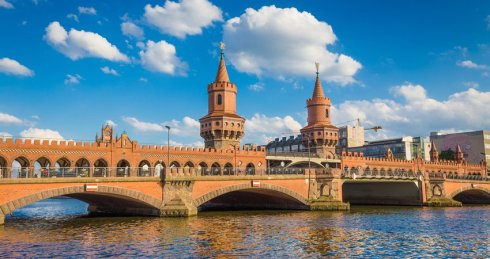
Oberbaum Bridge Photo Credit: Liz Weselby
Andru and his girlfriend Saskia both had work in the morning, and after having coffee with Andru, I decided to see the East Side Gallery and take a boat trip down the River Spree as a way to both see some sights and rest my torn meniscus knee. Before I left Los Angeles, I decided not to purchase phone service in Germany and instead to rely on my Wifi. This was definitely a mistake. While I pride myself on my sense of direction and my old school navigation capabilities, obviously a smartphone is such a useful tool especially when trying to navigate unfamiliar streets and Berlin’s daunting map of their S Bahn, U Bahn, bus, and tram system.
I wandered down to the river Spree. The East Side Gallery is a fantastic 1.3 kilometer-long collection of art that covers the former Berlin Wall. Most parts of the wall were dismantled after 1989, but the 1.3 km East Side Wall remains as a symbol of freedom (Hasselhoff “Looking For Freedom” anyone?). The graffiti art displays political messages, artistic visions and messages of hope after the fall of the Berlin wall.

“Mortal Kiss” by Dimitri Vrubel, showing Erich Honecker and Leonid Brezhnev in a lip lock
To rest my knee, I bought a ticket on the first 2.5 hour boat ride down the River Spree at 10:30am and had a coffee and a sandwich while I waited. I foolishly turned down the 3 Euro English translation, and on a boat full of German tourists, sat on the top deck in the sweltering summer heat while the monotone pre-recorded tour played in German for 3 hours. (I caught that Adolf Hitler did something off to the right of the boat, the German tourists stood and took photos. I really wanted to know what happened).
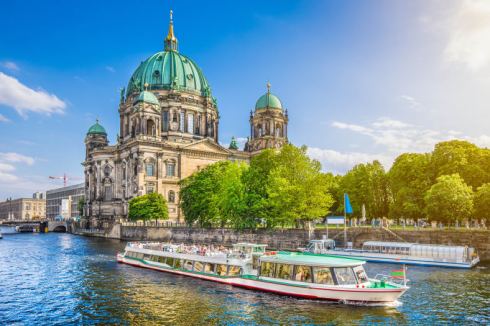
The boat trip was gorgeous. We did a loop on the Spree through the heart of the city. Berlin’s summer has been unusually hot and atypically long, so there were plenty of shirtless rotund German men sunbathing in Berlin’s many parks alongside the river. Through the canal we went through Kreuzberg, past the Technology Museum (Deutsches Technikmuseum) and up through Zoologischer Garten and Tiergarten before passing Museumsinsel (Museum Island) with a beautiful view of the Berlin Dome.
On the boat they served Beer, coffee, and food. After a coffee I had 2 beers during the course of the 3 hour tour. While Germans are strict rule takers and rule givers, they are extremely relaxed about drinking and smoking. The staff of the boat lit up cigarettes on the top deck around the small children and old people. The smoke even seemed to bother some of the older women, but they didn’t say anything. If it’s not against the rules, why bother complaining?
The boat captain smoked cigarettes and drank a Red Bull. He told some jokes in German in between the pre-recorded tour and the mostly older German tourists laughed at his jokes and gave him a hearty round of applause at the end of the tour. As Berlin is a capitol of culture as well as counter culture, the stereotype is that everyone in Berlin has dyed hair, piercings and tattoos. The boat conductor and the two men working on the boat all had prominent tattoos and piercings, so maybe the stereotype exists for a reason.
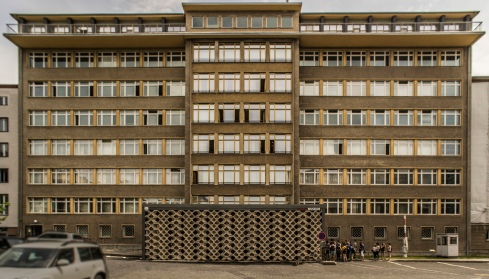
The Stasi Museum, in the former Stasi Headquarters, Lichtenberg, Berlin. Photo Credit: Gordon Haws
After the boat ride, I decided to check out the Stasi Museum. The Stasi Museum is located in the headquarters of The Ministry for State Security (MFS) AKA The Stasi. Three floors of exhibits take you through the offices of the Stasi showing their various surveillance devices, their infiltration of all parts of East German society, their brutal methods of blackmail and extortion, and the intact office of Erich Mielke, the last GDR Minister for State Security, which is preserved in its original condition. It was an extremely powerful and interesting museum, with an unforgiving presentation.
There’s something uniquely creepy about walking through this building, through these offices, seeing the faces and the names of the Stasi and their official duties. It was a frightening time. In Berlin they seem to excel at presenting these vicious facts in a unvarnished way. It’s a way of respecting the victims of oppression while holding those responsible to naked accountability.
The museum presentation is direct and brutal – just like the perpetrators of these inhumane offenses were. I would highly recommend visiting the Stasi Museum to fans of the 2006 film The Lives of Others (original German title: Das Leben der Anderen). When I get back home, I’m going to watch the movie again for a fresh perspective after being inside of Erich Mielke’s office. (Edit: After nursing my travel exhaustion at home, I re-watched the film and loved it even more. If you haven’t seen it, please do watch The Lives of Others. It’s available to rent on YouTube in the States for $3)
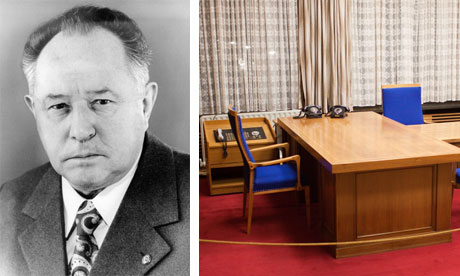
Erich Mielke, head of the Stasi, and his office in The Stasi Museum. Photo Credit: Alamy
What particularly stood out to me about Mielke’s office was seeing his extremely rigid breakfast demands. He provided a crudely drawn but insanely specific diagram for his secretaries. Mielke demanded that his breakfast be served in a strictly particular way. The bread, eggs, and other breakfast foods had to be placed on a specific part of his plate (or else). The secretaries kept his hand-drawn breakfast paper for any new hires to learn how to present this megalomaniac with his breakfast and not be subject to his certain ruthless castigation. His child-like drawing is displayed just outside of his office.
The heat was even more intense in the Stasi’s old HQ and after 3 floors of this stifling environ, I was ready for a beer.
I bought 4 trips on the S-Bahn (Stadtschnellbahn – city rapid railway) ) and U-Bahn (Untergrund-bahn – underground railway) which was given to me on four separate tickets. A ticket has to be punched to validate it before boarding the train and they love to inspect the trains and give stiff fines to anyone who doesn’t validate their ticket. I thought that my ticket just had to be punched once in the morning, but I was incorrect and a fare enforcement official forced me to depart the train while he printed me out a 60 Euro fine. A ticket has to be punched every 2 hours (unless a day pass is purchased) which I did not know. This 2 hour rule was not clear on the ticket machine or the ticket, and as I’m not fluent in German, I did not know this. The ticket guy was very friendly, however and chatted with me as he printed out my fine paperwork. (I didn’t pay the 60 Euro fine. We’ll see if they mail it to me)
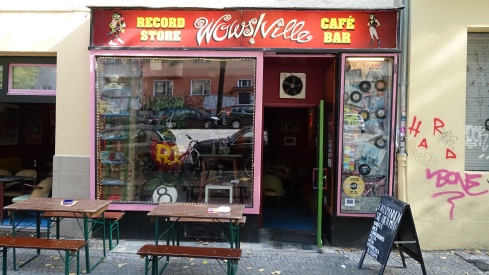
In my familiar stomping ground of Kreuzberg, I strolled over to Coretex Record Shop where Andru my friend and bass player works, and he had already left for the day. I went down Wiener Strasse to visit my old friend Oihane at Wowsville Record Store and Bar, turned on Ohlauer Str. and had a very lovely couple of beers there. If you love old rock and roll, then you will love Wowsville. (I have yet to try Wowsville Pizza across the street although everyone tells me that it is great)
In the evening, my old friends Tim and Imke invited me to a BBQ on the rooftop terrace of their flat in Kreuzberg. Their whole apartment building seemed to have the same idea, and there were four separate groups of friends and family all enjoying Berlin’s extended summer. The rooftop had a great view and Tim’s BBQ sausages were excellent. We drank Sekt, German sparkling wine, and some white wine, then had a Campari and Soda after dinner while enjoying their rooftop view of Kreuzberg. Excellent stuff. A fantastic close to my first day in Berlin.
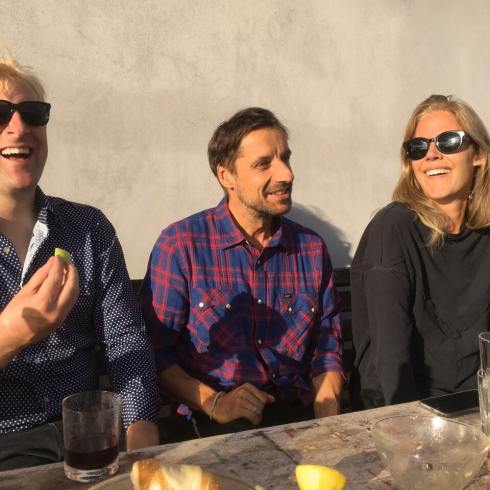
Me and the neighbors enjoying the rooftop sun. Photo Credit: Imke Wagener
BERLIN DAY 2
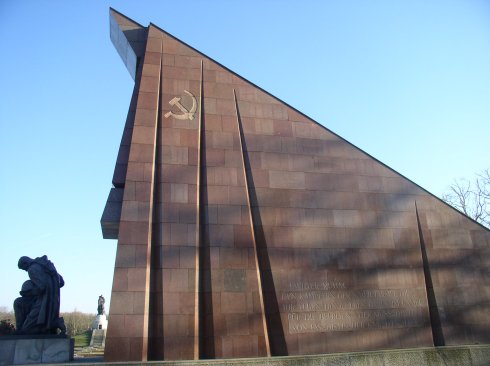
Soldier, statue, and banner at the Soviet War memorial in Treptower Park. Berlin. Photo Credit: JoeP
On the recommendation of a few German friends, I went to Treptower Park to see the largest Soviet monument outside of Russia. Soviet Troops experienced the highest number of casualties out of all the Allies during WWII, 8.7 million. 20,000 Red Army troops were killed in 1945 during the final month of fighting in Berlin. In Treptower Park, the Soviets built the monument to honor their fallen troops during the war, and 7000 were buried there. Stark, patriotic, and massive, the monument is truly something to see. I had conflicting feelings on the monument after reading about the brutal rape of German women at the hands of Soviet troops. From Wikipedia:
Estimates of the numbers of German women raped by Soviet soldiers have ranged up to 2 million. According to historian William Hitchcock, in many cases women were the victims of repeated rapes, some as many as 60 to 70 times. At least 100,000 women are believed to have been raped in Berlin, based on surging abortion rates in the following months and contemporary hospital reports, with an estimated 10,000 women dying in the aftermath. Female deaths in connection with the rapes in Germany, overall, are estimated at 240,000.Antony Beevor describes it as the “greatest phenomenon of mass rape in history”, and has concluded that at least 1.4 million women were raped in East Prussia, Pomerania and Silesia alone. According to Natalya Gesse, Soviet soldiers raped German females from eight to eighty years old. Soviet and Polish women were not spared either. When General Tsygankov, head of the political department of the First Ukrainian Front, reported to Moscow the mass rape of Soviet women deported to East Germany for forced labour, he recommended that the Soviet women be prevented from describing their ordeal on their return to Russia.
When Yugoslav politician Milovan Djilas complained about rapes in Yugoslavia, Stalin reportedly stated that he should “understand it if a soldier who has crossed thousands of kilometres through blood and fire and death has fun with a woman or takes some trifle.” On another occasion, when told that Red Army soldiers sexually maltreated German refugees, he reportedly said: “We lecture our soldiers too much; let them have their initiative.”
Obviously, heinous war crimes were committed by Nazi soldiers and many atrocities were experienced by scores of civilians during both world wars, but it seems that the rape of 2 million German women, 100,000 in Berlin alone, by Red Army troops, hasn’t been adequately addressed.
That said, its important to keep in mind that out of the nearly 9 million Russian troops killed during the war, and the 20,000 who died during the final days of fighting in Berlin, many of them were undoubtedly good people. They were mostly young men who were conscripted into war without a choice, and they had to kill or be killed. War has the capability of turning good men into monsters, animals, devoid of any sense of morality.
We truly need to learn from the past in order to ensure that these types of atrocities won’t happen again. Unfortunately when one looks with a clear perspective into Palestine, Syria, Afghanistan, Iraq, and Ukraine, it doesn’t look like we are doing too well learning from our ancestors’ horrendous mistakes. War should be avoided at all cost.
Sorry to be so heavy here, but its a heavy subject. Does anyone need a beer yet?
DAY 2 BERLIN (Continued)
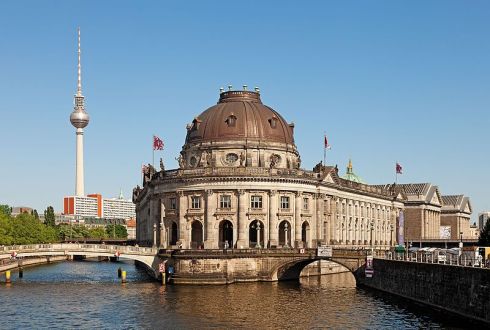
Museumsinsel (Museum Island. The Fernsehturm Berlin – Berlin’s TV tower in the background. This East German TV tower was used to transmit signals to GDR East Berlin and beyond. It remains the tallest structure in Germany.) Photo Credit: Thomas Wolf
In the afternoon I went to the DDR Museum near Museumsinsel. There was a line and it was packed full of tourists. While the hands-on exhibits are presented in an interesting way, somehow the museum didn’t hit me as hard as the Stasi Museum did. While the DDR Museum tries to present what life was like in East Germany from the 50s to present I don’t think it adequately showed the fear, the stress, the hopelessness of many who lived in the DDR although there were quite a few people who were perfectly happy in the DDR and some even preferred the more simple way of life after the fall of the Berlin wall brought capitalism to the formerly socialist state. I bought a couple of tacky presents in the gift shop and continued my wandering.
I walked over to Museum Island, Museumsinsel to take a rest inside of the Berliner Dome, a beautiful cathedral, constructed between 1894–1905 under the supervision of Kaiser Wilhelm II. The roof was destroyed by a fire bomb during the 1940s and it took many years to repair. The crypt below the church has the bodies of some important folks including various Kaisers, a young princess, and some prominent former members of the church. It was beautiful inside and very quiet which was a nice respite from the extremely frantic tourist activity going on outside.
After resting in Berliner Dome and exploring the crypt below, I headed over to the Neus Museum on the recommendation of my friends Imke and Tim. The Egyptian exhibit was phenomenal. The sarcophogi and the presentation on the Egyptians concept of their underworld was fascinating and mysterious. I perused hundreds, maybe thousands of ancient Egyptian artifacts excavated by German archaeologists in the 1800s and 1900s.
However, the bust of Nefertiti had the most impact on me. Upon seeing her face, I felt like I knew her, it hit me emotionally. It hit me hard. I had seen the image many times before, but standing there, looking at her face, my eyes teared up as if I was looking into the face of an old friend, an old lover, someone I held dear. It was an incredible feeling.
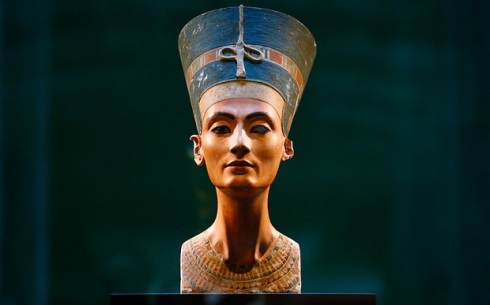
The Bust Of Queen Nefertiti in the Neus Museum, Berlin. Photo Credit: Getty
In the evening I took a quick rest back home in Friedrichshain then headed to a punk bar called K19 to see local band Berlin Blackouts play with Rotten from the Basque Country. I enjoyed the show and the 2 Euro beers. The Basque punks who had taken over the bar quickly drank all of the cold beer, and when there was only warm beer left, I headed home. Both bands were enjoyable and the crowd reaction to their Basque compatriots was truly wild and rowdy. For a moment I felt like I was in an ocupa in a pueblo in the Pais Basquo, drinking Pacharan with my rat-tailed, mulleted, fanny pack wearing friends.
Here’s Rotten Amairu. This song rules pretty hard…
The word Amairu seems to have been taken from a movement in the 1960s and 70s in the Basque Country to re-establish Basque culture. I have toured the Basque Country a few times and my stepdad Pedro is from Bilbao, the biggest city in Pais Basquo. One of the small town Basque punks at K19 educated me on the 300 Basque political prisoners still held by Spain. While I disagree with any kind of violence including the tactics of ETA (who are/were what the IRA was to Ireland), I can understand the raw emotion behind ETA’s tactics. The Spanish dictator Franco cut the tongues of people who spoke their own language like Catalan, Basque, or Gallego. People were frequently imprisoned and tortured by the fascists for speaking their own language or practicing their own culture. I understand the raw emotion behind Basque separatism and Catalan separatism, but I don’t think separating from Spain is the answer.
I don’t think that Rotten Amairu realize that their Fred Perry polo shirts from England, their Adidas shoes from Germany, their Epiphone guitars from the US, and their Marshall amps from England are not manufactured in the Basque country, and that separation, like Brexit, could increase the cost of imports double or triple the cost of what they paid for their Oi!/punk gear. Just a practical observation of an incredibly emotional and volatile subject.
Between 1968 and 2002 about 800 people were killed in Spain as a result of ETA attacks, about 2,000 injured. 343 of the 829 people killed were civilians. I understand the anger towards Fascist Franco Spain, but disagree with killing and maiming innocent people because of separatist politics and also disagree with punk bands who may sympathize with ETA. I cant speak for the punk band Rotten Amairu from Larraga -Tafalla, Basque Country, but I am assuming that they sympathize with ETA. Maybe I am wrong. Please correct me if I am wrong.
That said, the Rotten Amairu song I posted above is pretty damn good. Please check it out. I do have a soft spot for the Basque Holy Trinity of pacharan, pintxos, and brutalll punk rock after all.
DAY 3 BERLIN
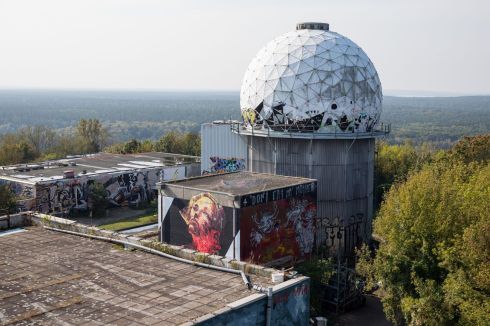
Abhörstation on Teufelsberg. An abandoned Cold War-era NSA listening station.
I’ve been everywhere, man…
ON DAY 3 IN BERLIN, my friends Tim and Imke took me everywhere. Tim temporarily had a rental car because of one of his jobs being located quite far away. They kindly took this as a chance to jetset me around Berlin. As Tim told me during the high-speed breakneck tour, as Berlin was separated into East and West, Berlin often has 2 pairs: two Zoos, 2 Opera Houses, 2 sets of government buildings, 2 TV towers, and so on. We were to see many of these pairs today.
I don’t remember the order of Timke’s grand tour de Berlin, but I do remember the key stops:
Kongresshalle Berlin AKA: Die schwangere Auster: The Pregnant Oyster
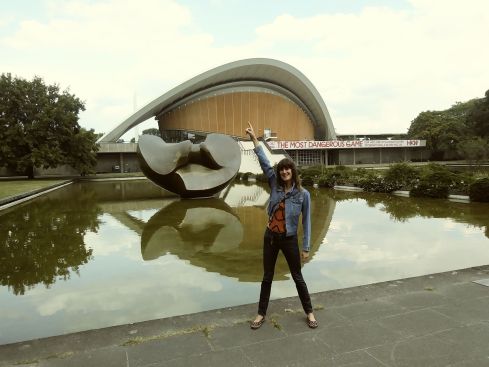
Imke in front of Kongresshalle Berlin AKA “Shwangerer Auster” (the pregnant oyster) PhotoCredit: Justin Maurer
Abhör Station on top of Teufelsberg – massive American NSA listening station from the cold war.
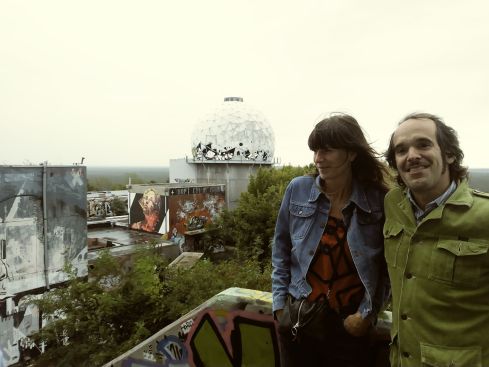
Imke and Tim at Teufelsberg. Photo Credit: Justin Maurer
Kaiser Wilhelm Church: bombed out, bullet riddled and the incredible rebuilt chapel next to it. The pastor in the 1930s and 40s was jailed multiple times for speaking out against the Nazis. The church was heavily damaged in an air raid as well as damaged by scores of bullets and shells during heavy fighting during the final days of the war. The interior of the new church next door is absolutely breathtaking. It has 21,292 stained glass inlays which were imported from France. The glass, designed by Gabriel Loire, was inspired by the colors of the glass in Chartres Cathedral. As Berliners love to give their buildings nicknames, Kaiser Wilhelm Church is nicknamed “der hohle Zahn”, “the hollow tooth” and the new church is nicknamed “Lippenstift und Puderdose”, “the lipstick and the powder box”.
One fond memory is looking down on the monkeys from the mall next to Zoologischer Garten (rot arsch pavian)
Bernauer Strasse – Berlin Wall Memorial, honors all who died trying to escape with their individual photographs. They also have a simulated view of the death strip with a self-manned automatic machine gun. Seeing the original wall at Bernauer Str. was very powerful.
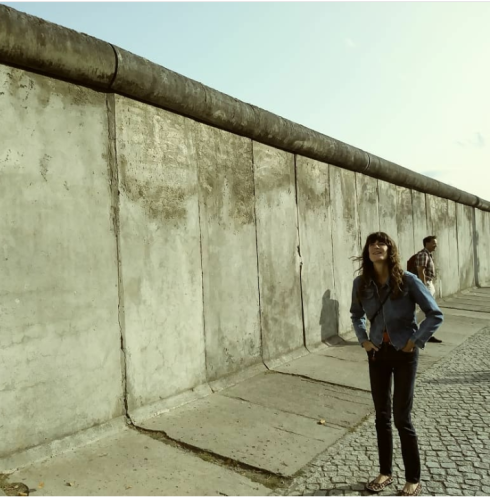
Imke at Bernauer Str. Berlin Wall Memorial. Photo Credit: Justin Maurer
The Holocaust Memorial
The Memorial to the Murdered Jews of Europe (Denkmal für die ermordeten Juden Europas) is also known as the Holocaust Memorial (Holocaust-Mahnmal).
This memorial to Jewish Holocaust victims consists of 2,711 concrete slabs placed on a sloping field. Walking through the concrete maze gives one the feeling of claustrophobia, or feeling trapped, lost. The slabs are organized in rows, 54 of them north–south, and 87 heading east–west at right angles but set slightly askew to contribute to the feeling of confusion, perhaps hopelessness as one wanders through the maze. An attached underground “Place of Information” (Ort der Information) holds the names of approximately 3 million Jewish Holocaust victims.
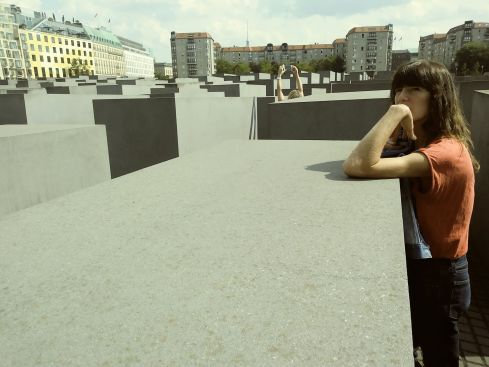
Imke at the Holocaust Memorial. Photo Credit: Justin Maurer
Across the street from the Holocaust memorial is the bluntly-titled Memorial to Homosexuals persecuted under Nazism (Denkmal für die im Nationalsozialismus verfolgten Homosexuellen)
Through a concrete slab, there is a video on replay that shows same-sex couples kissing. It is a simple– yet touching monument.
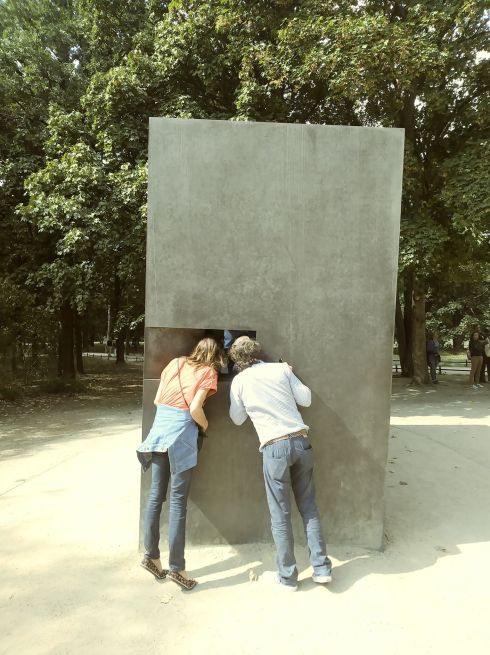
Imke and Tim looking at the same-sex couples kissing video displayed in the obtusely titled “Memorial to Homosexuals Persecuted Under Nazism”
Brandenburger Tor
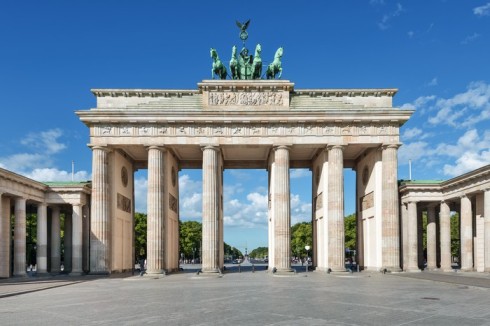
Brandenburger Tor AKA The Brandenburg Gate
Reischtag
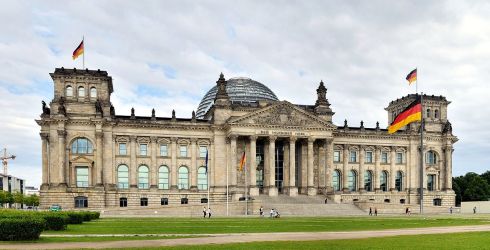
The Reichstag (Reichstagsgebäude or Deutscher Bundestag – Plenarbereich Reichstagsgebäude) – The house of German Parliament
Das Bundeskanzleramt AKA The German Chancellery serves the executive office of the Chancellor of Germany, currently Angela Merkel.

Das Bundeskanzleramt (Angela Merkel’s place)
In between we took a break for Beer and sausages at a Beer Garden in Tiergarten Park: Schleusenkrug. (The red sausages were amazing, I’m still dreaming about them)

And we closed our day with a beer at Beer Hall in Prenzlauer Berg Prater Garten

Prater Garten historic Beer Hall in Prenzlauerberg
Many thanks to my old friends Imke and Tim for the best tour of Berlin.
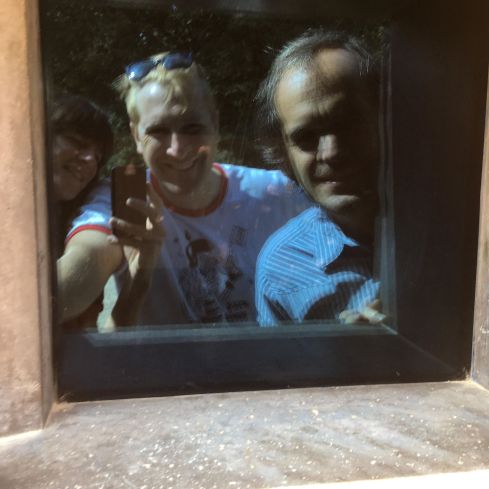
Imke, Justin, and Tim Photo by Imke Wagener.
FINAL THOUGHTS
I had so much on my mind about Berlin. All that I could do was let it sink in. Berlin is far from undiscovered territory as English-speaking tourists and trust fund kids of all stripes flood into Germany’s capital. Like most major cities across the world, Berlin is experiencing gentrification, housing-shortages, and major rent increases. Google has even sunk its claws into counter-culture stronghold Kreuzberg, opening up shop on Ohlauer Strasse (much to the chagrin and anger of locals).
That said, a beer in the supermarket is about 50 cents and a beer at the “Speti” is about 1.50. You can still find falafel for 3 or 4 Euros. There’s amazing international food everywhere including Turkish, Sudanese, Vietnamese, and more. The city is walkable, bikeable, and the public transportation while it can be erratic and confusing, for the most part works. The winter is brutal but the spring and summer are gorgeous. Parks and green spaces are everywhere.
At times Berlin can feel like a trendy cesspool full of the worst kind of faux-bohemians. Below this veneer is the real Berlin: full of history, full of culture, full of multi-lingual, well-traveled, well-educated people who care. It can still be a magical place at times. Just don’t be one of those Americans who moves to Berlin and never learns German. When I was digging around a little looking at other blogs, it was astounding to find people who describe themselves as “Berlin bloggers and freelance yoga instructors.” Maybe I shouldn’t have a bias against trust fund kids, but sorry, I do. (Kudos to those lucky few who can actually pay their rent in Berlin by blogging and freelance yoga instructing, but seriously, please give me a break!)
I am lucky enough to play in a few rock and roll bands and it still gives me the opportunity to travel sometimes. I’m very blessed. I’m even luckier to have dear friends in Berlin who always make me feel at home. It’s truly incredible to have a city full of friends on the other side of the world. Thank you, Berlin.
PARTS II AND III Coming Soon!
PART II: WARSAW and PART III: SUSPECT PARTS DEUTSCH TOUR JOURNAL as well as the complete Season 2 of your favorite travel show, GUTEN MORGEN DEUTSCHLAND!
Keep your eyes peeled.
Your Pal,
Justin












